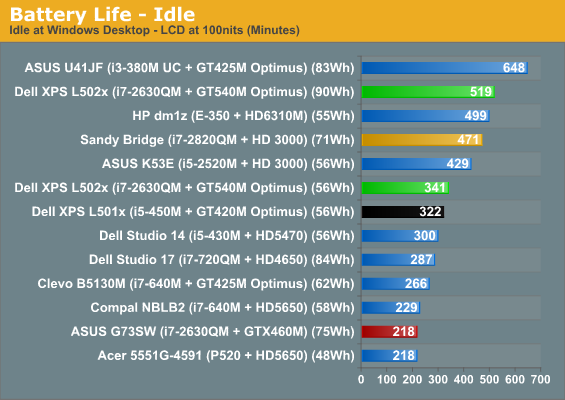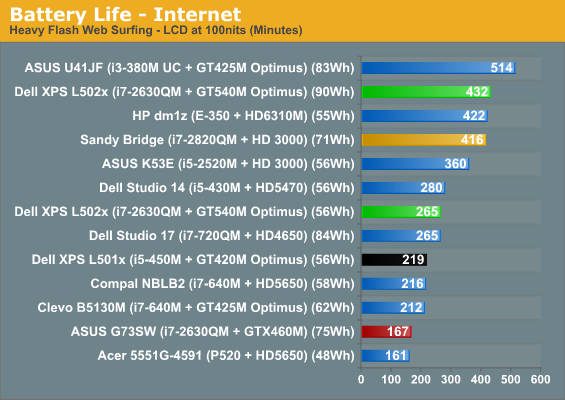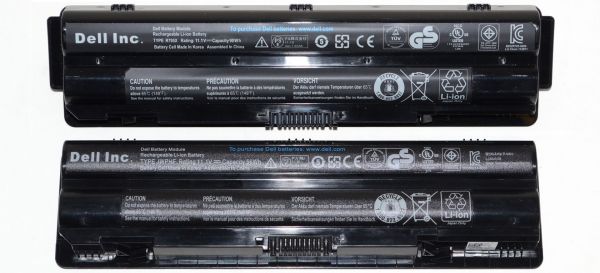Dell XPS 15 L502x: Now with Sandy Bridge
by Jarred Walton on April 20, 2011 1:10 AM ESTBattery Life: Better than the L501x
As mentioned earlier, Dell shipped us a 90Wh (the website states 92Wh, but our battery rates itself at 90Wh) battery for this review. However, we still have one of their 56Wh batteries from the previous XPS models available, so we tested both configurations. With the move from dual-core Arrandale to quad-core Sandy Bridge, plus a faster GT 540M GPU and HD 3000 IGP, we weren’t sure what would happen to battery life. It turns out that even sticking with the 6-cell battery, the L502x surpasses the L501x in all three of our battery life metrics. That’s good, because the large bump on the bottom of the laptop that the 9-cell upgrade brings into play is a real drawback. Here are the results.




We’ve noted in the past that Sandy Bridge really improved H.264 playback power/battery requirements, and that shows up in our charts again. Compared to the L502x with a 90Wh battery, the smaller ASUS U41JF and its 83Wh battery still comes out ahead in our Idle and Internet results (though keep in mind that the U41JF has to throttle the Core i3 clocks way back to get those results). In the H.264 test, however, the 90Wh Dell comes out with more than a one-hour lead over the next closest competitor. Even looking in Bench, the only laptops we’ve tested that offer better relative battery life for H.264 decoding use either Atom, Brazos, or CULV processors—and the dual-core SNB chip also does better than the quad-core SNB chips. Those are all far slower architectures, so the fact that SNB is even in the discussion is a feather in Intel's cap.
Battery life in general isn’t class leading for the XPS 15, but it’s good enough to satisfy most mobile users. With the standard 6-cell/56Wh battery, you can get 3.5 hours of video viewing, up to 4.5 hours of web surfing (more if you’re on simple web sites), and nearly six hours of idle battery life. Buy the larger battery and you’re looking at 8.5 hours idle, over 7 hours of Internet surfing, and nearly six hours of video playback. The relative performance of the two batteries also scales almost perfectly with cell count and capacity—the 9-cell lasts 52 to 63% longer than the 6-cell.
Rounding things out, we also tested a few other items, again with both batteries. In simulated gaming (looping 3DMark06/03), the L502x manages just 59 to 64 minutes on the 6-cell battery and 86 to 96 minutes with the 9-cell battery. Lower loads are clearly where hybrid laptops excel, so the combination of an active GPU and quad-core SNB is the exact opposite of a low load. Note also that unlike the GTX 460M, the GT 540M can run at full speed even on battery power (hence the low battery life). Setting the LCD to 100% brightness (instead of 40%, which corresponds with 100nits), idle battery life drops a rather large 27%, or in other words the LCD uses an extra ~3.9W for a 150nit increase in backlight intensity. That’s a lot more than we’ve seen with other laptop LCDs, but the 1080p panel is higher quality and gets brighter than much of the competition so we’re willing to cut it some slack.











76 Comments
View All Comments
JarredWalton - Wednesday, April 20, 2011 - link
On the Dell site, it's the "XPS 15", but the L501x is the actual full model, to differentiate it from the original L501x. It's like the MacBook Pro 13/15/17 -- they don't specify which particular iteration you're discussing. I just happen to use the real model instead of the generic name so as to avoid confusion.flyingpants1 - Wednesday, April 20, 2011 - link
If I follow the link in the article and configure the $800 XPS 15 with all the options listed, the total comes out to $1505. Coupon code 932N$0ZCCHWZB9 for an additional $70 off brings it to $1435.However, if I follow the link on this page: http://goo.gl/jgfvV configure THAT XPS 15 with the same stuff, the total is now $1764. $425 in coupon codes brings it down to $1339. So it actually works out cheaper, and it includes a 2 year service plan instead of the 1 year.
Wave_Fusion - Wednesday, April 20, 2011 - link
I'm not following which parts are plastic and which are metal.My old XPS M1210 was metal except in one key area: the palm rest.
So after about a year I wore an E.T. shaped hand print in the cheap silver paint below the keyboard.
It'd be a major disappointment to buy this one and find it still has crummy plastic where it shouldn't be.
If I've said it once I've said it a thousand times: My DV7 is better.
I don't get why no one seems to know about my computer, but eventually someone will review it besides myself.
Its faster, cheaper, most stylish; and also has amazing sound, but with a 2 year warranty too. I thought you guys announced the future launch of my computer, the DV6/DV7 spring refresh, but since then its been dark.
They destroy everything that's been reviewed since; and its sad no one seems to know about them yet.
will2 - Wednesday, April 20, 2011 - link
Re. your concluding paragraph, interested in your views of screen size/resolution combinations.As frequently moving, I want a thin-light desktop replacement notebook for both photo-editing, multimedia playing, and general business use. I concluded as my present 14" lcd with 1440x900 gloss screen is tiring on eyes for long hours reading office documents, a 15" 1600x900 screen - maybe less tiring as text rendered slightly larger. Interested in your thoughts on that.
With that in mind, I hope Anandtech can review the SNB Latitude E6520 with 1600x900 screen. Is that likely soon ?
You surmise the M11x R3 worth a look. Too small screen for my needs, but I see Notebookcheck just reviewed it and they said very powerful but let down by a poor screen, meagre 150:1 contrast ratio, blacks are grey.
JarredWalton - Thursday, April 21, 2011 - link
So it really depends on the individual, but I use a 30" desktop for most of my photo work, and when I have to go mobile I already feel cramped on 1080p (or even WUXGA). I've used 1440x900 and 1680x1050, and they're okay, but nothing beats resolution for photo editing in my book. The problem is, outside of photos, those fine dot pitches can really be a strain on the old eyes! Heck, my 30" is a strain these days.So then you use the DPI setting of Windows, but it mucks up certain programs and can be irritating, or you run at a lower resolution or use the "zoom" feature in your web browser and office applications as needed. I, incidentally, have used all of the above and continue to use them depending on my mood. My 30" LCD is set to 120dpi and it still feels a bit small on a lot of text.
For laptops, it's a compromise either way. Personally, I've ended up with the following sizes as my preferred options. Others will obviously disagree, but as a 37-year-old I don't have the luxury of running ultra-tiny fonts anymore.
-------------------
<12.1" - I'm not really a fan of this size laptop. It's too small for me to type on comfortably, so I prefer 13 or 14". However, 1280x800 (or 1366x768) works okay. I've used a 10.1" laptop with a 1366x768 LCD, and it was often too small to read comfortably.
13.3" - 1600x900 is a bit of a stretch for me at this size, but it's better than the 1366x768 alternative. 1280x800 is actually still better in my book, but too many laptops are moving to 16:9 aspect ratios.
14" - 1440x900 or 1600x900 works best; I'm not willing to go lower res if I can avoid it, and higher res is too small for my tastes.
15.6" - 1600x900 or 1920x1080 (or 1680x1050/1920x1200) are all fine here, though 1080p can be a bit small at times.
>17" - must have 1080p or 1920x1200 resolution. (I haven't seen anything in recent history with a higher resolution than that.)
NICOXIS - Thursday, April 21, 2011 - link
Is it possible to play games at native resolution with medium settings?Why should one get 540M when you can just do 525M with higher clocks? (besides additional memory)
What is the difference between Intel Advanced-N 6230 and Intel Wireless-N 1030?
If we replace Quad Core (Intel Core i7-2630QM) with Dual Core with higher clocks ( Intel Core i5-2520M), Should it get better performance at games and longer battery life?
Appreciate any answers! :)
Wave_Fusion - Thursday, April 21, 2011 - link
It might be possible, it might not. My HP DV7 can run most games at maximum at its native resolution of 1600 x 900, but my AMD 6770 is significantly faster than the 540M in this Dell.Medium settings at 1920 x 1080 could easily overwhelm a card like that. I'd recommend a unit with either Nvidia 555M, 560M; AMD Radeon HD 6770, 6870; or above.
Or the 540M would be fine if you played at a lower resolution; but if it were me I'd choose either a smaller laptop at 1366 x 768 or a larger one at 1600 x 900.
15 inches is to me a spot neither of Dell's offered resolutions look good at that size.
I believe the Advanced-N 6230 supports 5GHz band while the 1030 does not.
Finally, my DV7 has a quad core i7-2720QM and switchable graphics with the AMD 6770. The new quad cores idle pretty low, but because the dual core processors have a lower maximum thermal output, they'll draw less power under heavy load. On the other hand a quad core might handle that same load without stressing it too hard.
Short answer: Both are built on 32nm now, so probably little significant difference unless you're gaming or something.
JarredWalton - Thursday, April 21, 2011 - link
All of the gaming charts include the results at both our standard resolution as well as the native 1080p of the LCD. You can see that medium detail is >30FPS in five of the eight tested games, but of course that will vary depending on the game (and what settings you define as "medium"). For 1080p, realistically I still feel like you would want at least a GT 555M, and the GTX 460M is where medium to high 1080p is viable.Overclocking of mobile GPUs is possible, but in practice they bin pretty heavily and I'm uncomfortable trying to run a laptop with an overclocked GPU. I suppose it's only a 12% overclock to push the 525M to 540M levels, but YMMV. Since replacing your GPU on a laptop is difficult at best (i.e. finding a compatible part that doesn't cost an arm and a leg), I'd exercise caution. Besides, a 10% core overclock (with the same RAM speed) means the real-world performance difference is quite small.
WiFi 6230 gives 2.4 + 5.0 GHz connections, so it's a 2x2 MiMo setup. The 1030 is 1x2 and omits 5.0GHz support. Both support up to 300Mbps connections, but in the real world you'll probably max out around 144Mbps with actual throughput of around 7-9MBps (56-72Mbps).
As far as CPU changes, we do have performance results of the it-2520M in the charts (ASUS K53E). In games, the GPU is the major bottleneck. Remember that the 2630QM can still Turbo as high as 2.9GHz (2.8GHz dual-core, 2.7GHz tri-core, and 2.6GHz quad-core). The 2520M can go about 10% higher at 3.2GHz (3.1GHz dual-core), but unless you're playing at low resolutions and low details, you'll need more GPU than CPU.
NICOXIS - Thursday, April 21, 2011 - link
thanks Wave and Jarred, appreciate you took the time to respond ;)Regarding GPU at medium settings, there's no laptop I've seen (with L502x footprint and weight) that offers GT 555M or GTX 460M (or similar AMD solution) at that price point and price/features ratio.
On the overclocking side, isn't 525M the same exact chip as 540M with clocks up a 12%? or are you saying 525M are chips that didn't qualify at higher speeds?
And if that 10% overclock difference is minimal, Why should anyone upgrade anyway?
Reg 6230 vs 1030, what's the difference in practice?
Sorry for the blast, but it's interesting to know :D
Thanks
JarredWalton - Thursday, April 21, 2011 - link
So all of the GT 525M, 540M, and 550M chips are the "same", but they're the same in the way that the i7-2630QM, i7-2720QM, i7-2820QM, and i7-2920XM are the "same" (barring differences in L3 cache sizes). Without actually looking at a large sample, I don't know if NVIDIA is tweaking voltage levels, but they're very likely doing some form of binning.Intel for example will do some tests to verify a chip can handle the desired speed at a reasonable voltage; if it can't do 2.2GHz at 1.25V (or whatever), then they'll try for a lower clock with that same voltage, or maybe raise the voltage slightly but drop the clock, etc. I don't know all of what Intel does or doesn't do with binning, but in general their higher-end (e.g. more expensive) CPUs run at lower voltages at stock and overclock better with more voltage. So, considering the number of chips NVIDIA is offering that are essentially the same, I suspect they have a way of determining which are the better chips.
So if 10% is a minor difference in performance, why would anyone upgrade? Because they're generally uninformed. The 1GB to 2GB jump won't help at the settings where these chips run well -- which is usually lower resolutions at medium detail. 1GB to 2GB becomes useful when you're running at least 1080p with very large textures, and for that you really need at least a GTX 460M (or HD 5870M).
This is actually one of the frustrating aspects of buying a laptop. So many companies will sell you a GT 420M/425M/435M/525M/540M/550M graphics chip with Optimus in a 14" or 15.6" laptop. (Those are all 96 CUDA cores with 128-bit DDR3 memory, so basically the only change is the clock speed of the cores, which ranges from 500MHz on the 420M up to 740MHz on the 550M.) Finding anything with the GT 445M/555M on the other hand.... Well, the Alienware M14x and Dell XPS 17 L702x are currently the only laptops with the GT 555M, and to my knowledge the old XPS 17 L701x was the only laptop with the GT 445M. I'm not a big fan of 17.3" notebooks, so that's why I think the M14x may be the best balance of price, size, and performance for a gaming laptop.
Back to the wireless, in practice the difference is that if you have a wireless router that supports 2.4 and 5 GHz, you can get better throughput a lot of the time. Many less expensive routers don't support 5GHz, so in that case you'd see no difference at all. If you do have the appropriate router (I don't!), I understand that some people get much better performance on 5GHz because there's so much other traffic on 2.4GHz (e.g. 802.11b/g/n all use 2.4GHz, plus cordless phones and other devices).